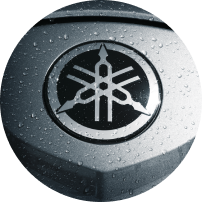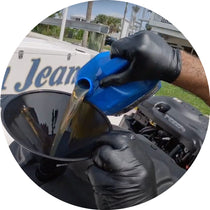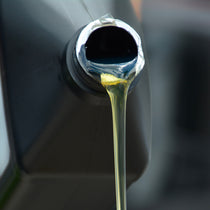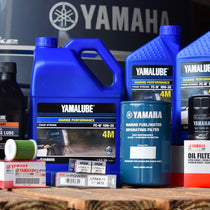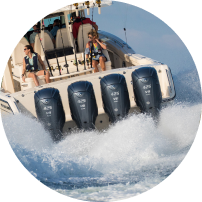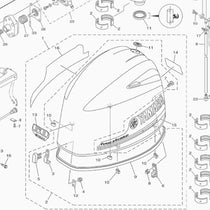Yamaha designs boats for performance, reliability, and longevity. Like any watercraft, Yamaha jet boats require proper care to operate at their best. Routine maintenance not only extends the life of your boat but also enhances fuel efficiency, safety, and overall enjoyment on the water. Below is a comprehensive guide to keeping your Yamaha jet boat in peak condition.
Engine Care: The Heart of Your Yamaha Jet Boat
Regular Oil and Filter Changes
Like a car, your Yamaha jet boat’s engine requires routine oil changes to function efficiently. Yamaha recommends using Yamalube 4M or other high-quality marine-grade oils that meet manufacturer specifications.
Changing the oil and filter at the proper intervals is essential to keeping the engine lubricated and free from debris buildup. Old oil can break down over time, reducing engine performance and causing potential wear. Always follow the schedule outlined in your owner's manual to prevent long-term damage.
When performing an oil change, use an oil extractor pump to remove the old oil efficiently, ensuring a clean process and preventing spills. Once the oil is drained, replace the Yamaha Boat oil filter with a Yamaha-approved oil filter to maintain peak filtration and prevent contaminants from circulating through the engine.
Proper disposal of used oil is critical for environmental protection. To ensure responsible handling, take the old oil and filter to a designated marine service center or recycling facility.
Fuel System Maintenance
Fuel quality significantly impacts your Yamaha jet boat’s performance. To prevent engine problems, use fresh, high-quality gasoline with a low ethanol content.
Adding Yamaha Fuel Stabilizer & Conditioner helps prevent fuel degradation, particularly if the boat will be stored for an extended period. Inspect fuel lines, fittings, and connections regularly for leaks or cracks to ensure proper operation. Fuel filters should be replaced annually or as needed to ensure clean fuel delivery to the engine.
Cooling System Checkups
Your Yamaha jet boat’s cooling system prevents the engine from overheating. Salt, debris, and sediment can accumulate, restricting water flow and causing overheating issues.
Flushing the engine with fresh water after every use in saltwater or brackish environments is necessary to remove corrosive elements. Always check the water intake for blockages before and after each outing. Inspect cooling hoses for wear, cracks, or leaks and replace them if necessary.
Hull and Exterior Maintenance for Yamaha Jet Boats
Cleaning and Protecting the Hull
A clean hull ensures better fuel efficiency and a smooth ride. Over time, algae, barnacles, and grime can accumulate, increasing drag and reducing performance.
Rinsing the boat thoroughly with fresh water after every outing helps remove salt and debris that could cause long-term damage. Cleaning the hull with a marine-safe boat soap and a soft brush will maintain the boat’s finish and prevent buildup. Apply boat wax every few months to protect against UV damage and oxidation. If you store the boat in the water, regularly inspect it for marine growth to prevent excessive accumulation.
Electrical System and Battery Maintenance for Yamaha Jet Boats
Keeping the Battery in Top Condition
A properly maintained battery ensures reliable starts and prevents unexpected failures. Keeping the battery fully charged when not in use helps prolong its lifespan. If you plan to store the boat for an extended period, use a trickle charger to maintain the battery charge without overloading it.
Inspect battery terminals for corrosion, as buildup can interfere with proper electrical connections. Cleaning corrosion with a wire brush and applying anti-corrosion spray can help maintain good conductivity. To prevent power failures, replace batteries that struggle to hold a charge or are over three to five years old.
Checking Lights and Electrical Components
Your Yamaha jet boat’s electrical system powers essential components such as navigation lights, bilge pumps, and engine electronics. Before heading out on the water, always test the navigation and deck lights to ensure they are operational.
Inspect all electrical connections to make sure they are tight and check for corrosion, as poor connections can lead to malfunctioning systems. Any wires that appear frayed or damaged should be replaced immediately to prevent shorts or electrical failures. Additionally, verify that the bilge pumps activate correctly to keep the boat free of excess water.
Seasonal and Long-Term Storage for Yamaha Jet Boats
Preparing Your Boat for Off-Season Storage
Properly storing your Yamaha jet boat during the off-season prevents long-term damage and ensures it's ready when boating season returns.
Draining all water from the engine and bilge before storage is essential to prevent freezing damage in colder climates. Adding a fuel stabilizer to the tank and running the engine ensures that treated fuel circulates through the system, preventing fuel breakdown and varnish buildup.
Removing and storing the battery in a dry, cool place extends its lifespan and prevents unexpected failures. A breathable Yamaha boat cover protects the boat against dust, UV exposure, and moisture. In regions with cold winters, fogging the engine with Yamaha Fogging Oil prevents internal corrosion and extends engine life.
Frequently Asked Questions (FAQ) About Yamaha Jet Boats
Q: How often should I flush my Yamaha jet boat’s engine?
A: If you use your Yamaha jet boat in saltwater or brackish water, you must flush the engine after every trip to remove salt and prevent corrosion. Flushing the engine after every few outings also helps remove debris and maintain optimal cooling system function, even for freshwater use. Regular flushing keeps internal passages clean and prevents blockages that could lead to overheating. If you boat in saltwater environments, it is highly recommended that you flush with a high-quality salt remover, like Salt Off, in addition to fresh water.
Q: Can I leave my Yamaha jet boat in the water for long periods?
A: Some boats handle extended water exposure, but leaving them in the water too long causes hull fouling, marine growth, and corrosion. If you must leave your Yamaha jet boat in the water, using a boat lift or floating dock helps minimize damage. Additionally, applying anti-fouling paint to the hull reduces marine growth and makes cleaning easier. Regular inspections ensure that prolonged water exposure doesn’t compromise performance or longevity.
Q: How do I prevent fuel system issues when storing my boat?
A: Adding a fuel stabilizer before storage prevents fuel from breaking down and forming harmful deposits. Running the engine for a few minutes ensures that treated fuel circulates through the entire system, protecting injectors and fuel lines. Keeping the fuel tank full reduces condensation buildup, which can lead to water contamination. Proper fuel system care during storage ensures smooth startup when you’re ready to use the boat again.
Q: What’s the best way to safely transport my Yamaha jet boat?
A: Secure your Yamaha jet boat to the trailer correctly to ensure safe transport and prevent shifting during travel. Double-check the straps and connections before hitting the road. Always check that the trailer lights are working correctly to provide visibility on the road. Inspect tires for proper inflation and wear, and grease the trailer bearings to prevent overheating. Also, remember to remove drain plugs to prevent water from accumulating inside the hull. Taking these steps ensures safe and hassle-free transport for your Yamaha jet boat.
Final Thoughts
Keeping your Yamaha jet boat well-maintained ensures years of trouble-free performance and enjoyable days on the water. A proactive approach to engine care, hull maintenance, electrical system checks, and seasonal preparation will help you avoid costly repairs and maximize your boat’s lifespan. For more specific maintenance schedules and procedures, always refer to your Yamaha owner’s manual or consult a Yamaha-certified technician.
With proper care, your Yamaha jet boat will continue to deliver smooth and reliable adventures for years to come! PartsVu is always here to help.





